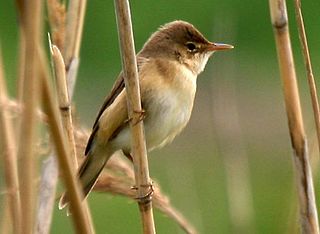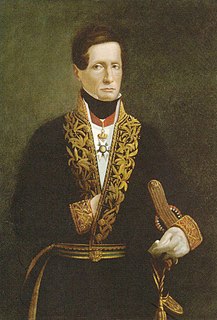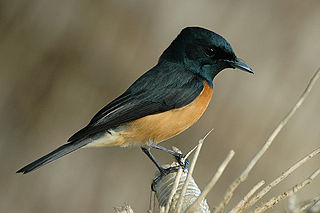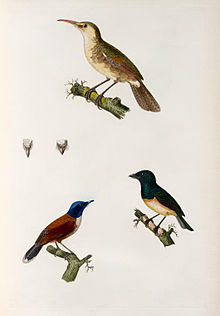
The Acrocephalus warblers are small, insectivorous passerine birds belonging to the genus Acrocephalus. Formerly in the paraphyletic Old World warbler assemblage, they are now separated as the namesake of the marsh and tree warbler family Acrocephalidae. They are sometimes called marsh warblers or reed warblers, but this invites confusion with marsh warbler and reed warbler proper, especially in North America, where it is common to use lower case for bird species.

The Eurasian reed warbler, or just reed warbler, is an Old World warbler in the genus Acrocephalus. It breeds across Europe into the temperate western Palaearctic. It is migratory, wintering in sub-Saharan Africa.

The thick-billed warbler breeds in the temperate east Palearctic. South Siberia to West Mongolia.It is migratory, wintering in tropical South Asia and South-east Asia. It is a very rare vagrant to western Europe.

The moustached warbler is an Old World warbler in the genus Acrocephalus. It breeds in southern Europe and southern temperate Asia with a few in north-west Africa. It is partially migratory. South west European birds are resident, south east European birds winter in the Mediterranean breeding range, and the Asiatic race migrates to Arabia, India and Pakistan.

Joseph Paul Gaimard was a French naval surgeon and naturalist.

Jean René Constant Quoy was a French naval surgeon, zoologist and anatomist.

The yellow-rumped thornbill is a species of passerine bird from the genus Acanthiza. The genus was once placed in the family Pardalotidae but that family was split and it is now in the family Acanthizidae. There are four subspecies of yellow-rumped thornbill. It is a small, brownish bird with a distinctive yellow rump and thin dark bill. It inhabits savannah, scrub and forests across most of Australia and eats insects. The species engages in cooperative breeding.

The New Zealand fernbird or simply fernbird is an insectivorous bird endemic to New Zealand. In the Māori language, it is named kōtātā or mātātā.

The bare-backed fruit bat or Moluccan naked-backed fruit bat is a fruit bat in the family Pteropodidae.

The black-browed reed warbler is a marsh-warbler. It was formerly included in the "Old World warbler" assemblage. The species was first described by Robert Swinhoe in 1860.

The rusty-winged starling is a species of starling in the family Sturnidae. It is found in the Santa Cruz Islands and Vanuatu.

The paradise drongo or ribbon-tailed drongo is a species of bird in the family Dicruridae. It is endemic to New Ireland in the Bismarck Archipelago, Papua New Guinea. With a total length of 51 to 63 cm and body mass of 130 g (4.6 oz), this may be the largest species of drongo.

The White-breasted Robin is a passerine bird in the Australasian robin family Petroicidae and the Yellow Robin genus Eopsaltria. Occasionally it is placed in the genus Quoyornis. It is endemic to southwestern Australia. Unlike many other Australian robins, it lacks bright colours in its plumage, being a predominantly greyish bird with white underparts. Like other closely related Australasian robins, it is a cooperative breeder. It is sedentary, with pairs or small groups maintaining territories.

The dusky robin is a small passerine bird native to Tasmania. A member of the Australian robin family Petroicidae, it is known by many other names such as Dozey, Sad, Sleepy, Stump, Tasmania/Wood Robin; Native Sparrow or Sad Bird.

The hooded monarch is a species of bird in the family Monarchidae. It is found on New Guinea. Its natural habitat is subtropical or tropical moist lowland forests.

The Vanikoro flycatcher is a species of monarch flycatcher in the family Monarchidae. It has a slightly disjunct distribution, occurring on Vanikoro island and in Fiji.
The Pagan reed warbler was sometimes considered a subspecies of the nightingale reed warbler. It originally occurred on Pagan Island and "was extinct by the late 1970s". More precisely, in the 1970s, the 1980s, in 2000 and in 2010, the bird could not be found and is therefore presumed to be extinct.
The Mangareva reed warbler or astrolabe reed warbler is a presumed extinct songbird that existed on Mangareva in the Gambier Islands. It is known from only two specimens, and is believed to have gone extinct in the mid-19th century.

The Nauru reed warbler, Acrocephalus rehsei, is a passerine bird endemic to the island of Nauru in the Pacific Ocean. It is one of only two native breeding land-birds on Nauru and it is the only passerine found on the island. It is related to other Micronesian reed warblers, all of which evolved from one of several radiations of the genus across the Pacific. Related warblers on nearby islands include the Caroline reed warbler, with which the Nauru species was initially confused, and the nightingale reed warbler, which was formerly sometimes considered the same species.
The Aguiguan reed warbler or Aguijan reed warbler was a bird that originally occurred on the Northern Mariana Island Aguigan. It is considered a subspecies of the nightingale reed warbler by some taxonomists. Of this subspecies there never have been reports of a substantial population. In 1982 only four up to possibly 15 birds of the subspecies have been counted, and since 1995 none has been sighted, despite extended efforts to find specimens.


















